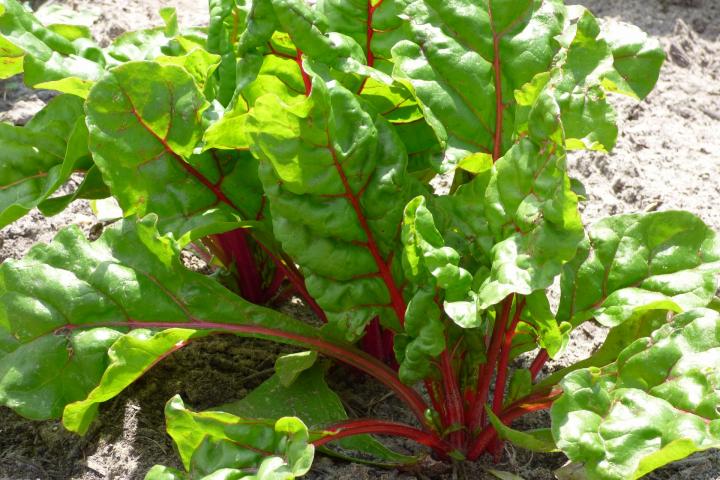
Swiss chard with its colorful stems.
Planting, Growing, and Harvesting Swiss Chard
The Almanac Garden Planner - Use It Free for 7 Days!
Plan your 2025 garden with our award-winning Garden Planner.
Types
- ‘Bright Lights’: Dark green leaves on multicolor stems; bolt-resistant but less frost-hardy.
- ‘Fordhook Giant’: Dark green leaves, white stems; compact plants.
- ‘Lucullus’: Green leaves, white stems; heat-tolerant.
- ‘Peppermint’: Green leaves, pink-and-white striped stems; bolt-resistant; good for containers.
- ‘Rainbow’: Red, pink, white, yellow, orange, and striped leaves and stems.
- ‘Rhubarb’: Dark green leaves, deep-red stems; sow after risk of frost has passed or it may bolt.
- ‘Ruby Red’: Green leaves, bright-red stems; sow after risk of frost has passed or it may bolt.
Cooking Notes
- Chard can be used in salads to add color, in smoothies, in soups and stews, on pizzas, in sandwiches in place of lettuce, in quiches, and anywhere you use spinach or kale (especially if you dislike the latter).
- Swiss chard holds its shape well when cooked and adds a nutritious boost.
ADVERTISEMENT
This is my second year of growing chard. I did not know I could harvest and it would keep growing! Entire website was very informative and interesting. Thank you for sharing your knowledge.
I let my swiss chard grow to about 12" tall. I remove the outside leaves, wash them & trim most of the stalk off (they can be a little tough & bitter when grown that tall). I stack the leaves on my cutting board & slice 1 -1 1/2" strips across the leaves top to bottom. I toss them in my double boiler & let them steam for 5-7 min. stirring them or turning them over every few min. to make sure all leaves are cooked. I move the pot to the sink, empty the water from the bottom pot, put the top pot (with the holes) back on the bottom pot, sit it aside & let the remaining water drain out. You can use a skillet or the bottom pot - slice or mince some garlic - I've even used just plain garlic powder (not garlic salt). Pour a thin layer of oil in your pan/pot & throw in your garlic & let it cook a few min. (Does not need to be browned) Add your steamed swiss chard, cook the chard to your liking. Add
more garlic & a little salt. This makes a great side dish or can be added to cooked pasta
with romano and/or parmesan cheese. If you like garlic & swiss chard, You'll definitely
like this. I also use this same recipe with fresh spinach leaves -delicious!
On a trip to the Biltmore Estate last year I enjoyed a side dish at the Stable Café. It had Swiss Chard, tomatoes, celery, and I'm not sure what else was in it but it was delicious. I wish I could find that recipe!
This year I tried to grow some Swiss Chard with moderate success. Only one plant grew but it keeps abundantly producing as long as I trim off the older leaves. It does look attractive in my little side flower garden.
We planted Swiss Chard in pots a couples of years ago, and they are still producing big delicious stalks. Otherwise, we mulched the entire yard last winter and have been greeted this spring by a massive increase in our earwig population. They keep coming and like Swiss Chard as much as I do.
It's the end of September here in So. Calif. Do I still have time to plant Chard?
Can I pot a chard plant in the center of a pot of flowers?Sounds attractive but will it grow well I have previously mixed bell peppers with the flowers but the last few years they weren’t very productive
It would certainly be worth trying out, as long as the soil is rich and stays relatively moist. Because the flowers will be taking their fair share of nutrients and water from the soil, the Swiss chard likely won’t be as productive as it might be otherwise, so I would advise applying an extra dose of fertilizer as the chard starts to take off.
I live in Lexington South Carolina, so you know it’s going to be extremely hot in about another month. Does this plant thrive in full sun? I have never planned Chard before but your article intrigued me and I thought I would give it a try. Thanks!
Swiss chard is more heat tolerant than a number of other common greens, but its growth will slow down when temperatures rise. If you plant it now, don’t expect a particularly large harvest if the heat does arrive. In fact, you might be better off waiting until late summer to plant for a fall harvest—it does best when it can mature with cooler temps. In any case, be sure to keep it well watered, especially if grown in full sun and in hotter temperatures.
I keep a raised bed between 2 coops of chickens, yearly. It is very easy to grow and last through the hot summer with daily watering as I service the flocks. I harvest it as a cut (large outside leaves ) & come again. This year my husband built a high tunnel frame for it to extend the harvest into early winter. When it is finally finished, we clean out one of the coops right into the bed, turn it in & it is ready for seed early next spring. The "Girls" love their beautiful chard!











